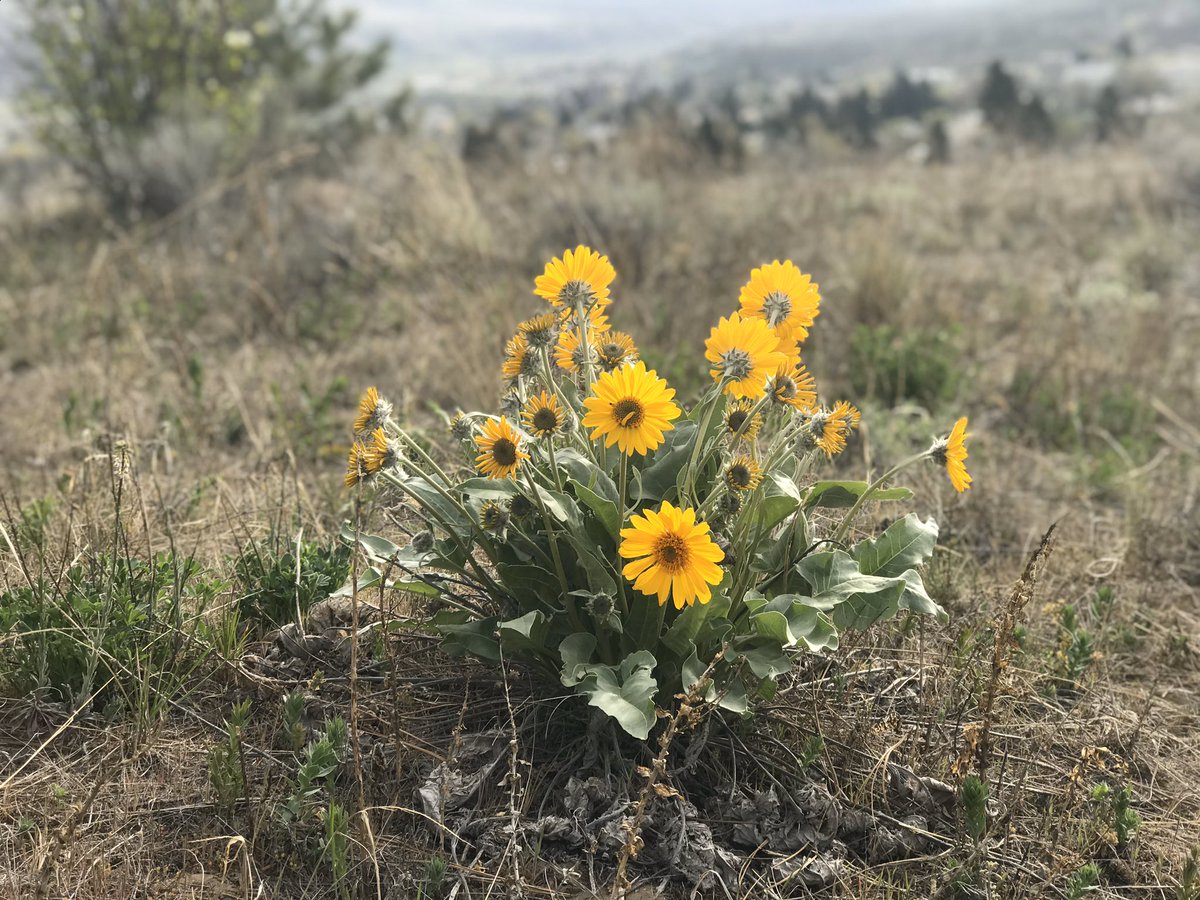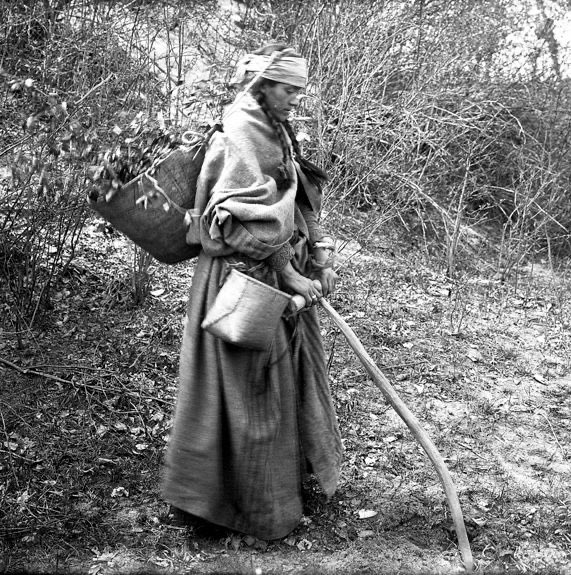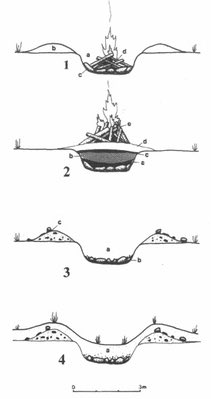Balsamroot is one of a number of root/bulb foods managed on the Plateau to maximize reliable production. A digging stick was used to uproot plants and loosen soil, then extra roots were replanted for future harvests. ( https://abs.twimg.com/emoji/v2/... draggable="false" alt="📷" title="Camera" aria-label="Emoji: Camera">AMNH of a Nlaka’pamux woman demonstrating)
https://abs.twimg.com/emoji/v2/... draggable="false" alt="📷" title="Camera" aria-label="Emoji: Camera">AMNH of a Nlaka’pamux woman demonstrating)
Root digging was known to be a woman’s task, so the distinctive elk antler digging stick handles are one of few artifacts considered to be evidence of women in the archaeological record (cos otherwise who can say for sure women existed, right) ( https://abs.twimg.com/emoji/v2/... draggable="false" alt="📷" title="Camera" aria-label="Emoji: Camera"> R, Oregon Hist Project Museum)
https://abs.twimg.com/emoji/v2/... draggable="false" alt="📷" title="Camera" aria-label="Emoji: Camera"> R, Oregon Hist Project Museum)
The roots needed a loooong roast in an underground pit oven to be edible. The rock-lined pits become bowl-shaped depressions, and when excavated are full of charcoal, fire-cracked rock, and sometimes fragments of the root itself. (Drawing, Ignace and Ignace 2017,  https://abs.twimg.com/emoji/v2/... draggable="false" alt="📷" title="Camera" aria-label="Emoji: Camera"> G Nicholas)
https://abs.twimg.com/emoji/v2/... draggable="false" alt="📷" title="Camera" aria-label="Emoji: Camera"> G Nicholas)
INTERESTINGLY, the roots aren’t easy to digest for bears either, and they’ve been observed digging them up, spreading them on the ground, then returning several days later to eat them. They’re thought to be “cooking” them in the sun?!

 Read on Twitter
Read on Twitter Look who’s blooming! Called tséts’elq in Secwepemctsin, balsamroot is a sunflower with a vitamin rich taproot that was a super important food and trade good on the Plateau. Small patches today are often remnants of plots cultivated over millennia. #beforeBC" title="https://abs.twimg.com/emoji/v2/... draggable="false" alt="💛" title="Yellow heart" aria-label="Emoji: Yellow heart"> Look who’s blooming! Called tséts’elq in Secwepemctsin, balsamroot is a sunflower with a vitamin rich taproot that was a super important food and trade good on the Plateau. Small patches today are often remnants of plots cultivated over millennia. #beforeBC">
Look who’s blooming! Called tséts’elq in Secwepemctsin, balsamroot is a sunflower with a vitamin rich taproot that was a super important food and trade good on the Plateau. Small patches today are often remnants of plots cultivated over millennia. #beforeBC" title="https://abs.twimg.com/emoji/v2/... draggable="false" alt="💛" title="Yellow heart" aria-label="Emoji: Yellow heart"> Look who’s blooming! Called tséts’elq in Secwepemctsin, balsamroot is a sunflower with a vitamin rich taproot that was a super important food and trade good on the Plateau. Small patches today are often remnants of plots cultivated over millennia. #beforeBC">
 Look who’s blooming! Called tséts’elq in Secwepemctsin, balsamroot is a sunflower with a vitamin rich taproot that was a super important food and trade good on the Plateau. Small patches today are often remnants of plots cultivated over millennia. #beforeBC" title="https://abs.twimg.com/emoji/v2/... draggable="false" alt="💛" title="Yellow heart" aria-label="Emoji: Yellow heart"> Look who’s blooming! Called tséts’elq in Secwepemctsin, balsamroot is a sunflower with a vitamin rich taproot that was a super important food and trade good on the Plateau. Small patches today are often remnants of plots cultivated over millennia. #beforeBC">
Look who’s blooming! Called tséts’elq in Secwepemctsin, balsamroot is a sunflower with a vitamin rich taproot that was a super important food and trade good on the Plateau. Small patches today are often remnants of plots cultivated over millennia. #beforeBC" title="https://abs.twimg.com/emoji/v2/... draggable="false" alt="💛" title="Yellow heart" aria-label="Emoji: Yellow heart"> Look who’s blooming! Called tséts’elq in Secwepemctsin, balsamroot is a sunflower with a vitamin rich taproot that was a super important food and trade good on the Plateau. Small patches today are often remnants of plots cultivated over millennia. #beforeBC">
 AMNH of a Nlaka’pamux woman demonstrating)" title="Balsamroot is one of a number of root/bulb foods managed on the Plateau to maximize reliable production. A digging stick was used to uproot plants and loosen soil, then extra roots were replanted for future harvests. (https://abs.twimg.com/emoji/v2/... draggable="false" alt="📷" title="Camera" aria-label="Emoji: Camera">AMNH of a Nlaka’pamux woman demonstrating)" class="img-responsive" style="max-width:100%;"/>
AMNH of a Nlaka’pamux woman demonstrating)" title="Balsamroot is one of a number of root/bulb foods managed on the Plateau to maximize reliable production. A digging stick was used to uproot plants and loosen soil, then extra roots were replanted for future harvests. (https://abs.twimg.com/emoji/v2/... draggable="false" alt="📷" title="Camera" aria-label="Emoji: Camera">AMNH of a Nlaka’pamux woman demonstrating)" class="img-responsive" style="max-width:100%;"/>
 R, Oregon Hist Project Museum)" title="Root digging was known to be a woman’s task, so the distinctive elk antler digging stick handles are one of few artifacts considered to be evidence of women in the archaeological record (cos otherwise who can say for sure women existed, right) (https://abs.twimg.com/emoji/v2/... draggable="false" alt="📷" title="Camera" aria-label="Emoji: Camera"> R, Oregon Hist Project Museum)">
R, Oregon Hist Project Museum)" title="Root digging was known to be a woman’s task, so the distinctive elk antler digging stick handles are one of few artifacts considered to be evidence of women in the archaeological record (cos otherwise who can say for sure women existed, right) (https://abs.twimg.com/emoji/v2/... draggable="false" alt="📷" title="Camera" aria-label="Emoji: Camera"> R, Oregon Hist Project Museum)">
 R, Oregon Hist Project Museum)" title="Root digging was known to be a woman’s task, so the distinctive elk antler digging stick handles are one of few artifacts considered to be evidence of women in the archaeological record (cos otherwise who can say for sure women existed, right) (https://abs.twimg.com/emoji/v2/... draggable="false" alt="📷" title="Camera" aria-label="Emoji: Camera"> R, Oregon Hist Project Museum)">
R, Oregon Hist Project Museum)" title="Root digging was known to be a woman’s task, so the distinctive elk antler digging stick handles are one of few artifacts considered to be evidence of women in the archaeological record (cos otherwise who can say for sure women existed, right) (https://abs.twimg.com/emoji/v2/... draggable="false" alt="📷" title="Camera" aria-label="Emoji: Camera"> R, Oregon Hist Project Museum)">
 G Nicholas)" title="The roots needed a loooong roast in an underground pit oven to be edible. The rock-lined pits become bowl-shaped depressions, and when excavated are full of charcoal, fire-cracked rock, and sometimes fragments of the root itself. (Drawing, Ignace and Ignace 2017, https://abs.twimg.com/emoji/v2/... draggable="false" alt="📷" title="Camera" aria-label="Emoji: Camera"> G Nicholas)">
G Nicholas)" title="The roots needed a loooong roast in an underground pit oven to be edible. The rock-lined pits become bowl-shaped depressions, and when excavated are full of charcoal, fire-cracked rock, and sometimes fragments of the root itself. (Drawing, Ignace and Ignace 2017, https://abs.twimg.com/emoji/v2/... draggable="false" alt="📷" title="Camera" aria-label="Emoji: Camera"> G Nicholas)">
 G Nicholas)" title="The roots needed a loooong roast in an underground pit oven to be edible. The rock-lined pits become bowl-shaped depressions, and when excavated are full of charcoal, fire-cracked rock, and sometimes fragments of the root itself. (Drawing, Ignace and Ignace 2017, https://abs.twimg.com/emoji/v2/... draggable="false" alt="📷" title="Camera" aria-label="Emoji: Camera"> G Nicholas)">
G Nicholas)" title="The roots needed a loooong roast in an underground pit oven to be edible. The rock-lined pits become bowl-shaped depressions, and when excavated are full of charcoal, fire-cracked rock, and sometimes fragments of the root itself. (Drawing, Ignace and Ignace 2017, https://abs.twimg.com/emoji/v2/... draggable="false" alt="📷" title="Camera" aria-label="Emoji: Camera"> G Nicholas)">
 G Nicholas)" title="The roots needed a loooong roast in an underground pit oven to be edible. The rock-lined pits become bowl-shaped depressions, and when excavated are full of charcoal, fire-cracked rock, and sometimes fragments of the root itself. (Drawing, Ignace and Ignace 2017, https://abs.twimg.com/emoji/v2/... draggable="false" alt="📷" title="Camera" aria-label="Emoji: Camera"> G Nicholas)">
G Nicholas)" title="The roots needed a loooong roast in an underground pit oven to be edible. The rock-lined pits become bowl-shaped depressions, and when excavated are full of charcoal, fire-cracked rock, and sometimes fragments of the root itself. (Drawing, Ignace and Ignace 2017, https://abs.twimg.com/emoji/v2/... draggable="false" alt="📷" title="Camera" aria-label="Emoji: Camera"> G Nicholas)">



